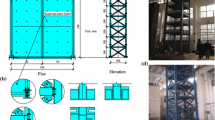Abstract
In this paper maximum response of a single degree of freedom system resting on a flexible base is determined under consistent earthquakes and the results are presented as acceleration spectra including soil–structure interaction (SSI). Flexibility of base is modeled using frequency-dependent springs and dampers. The spring–damper coefficients are calculated for the desired natural mode of vibration of a multi-degree-of-freedom system. Consistency of earthquakes is maintained considering their magnitude, distance, local soil type, and return period. The latter parameter is accounted for by the use of earthquake categories identified by their similar spectral values. Ratio of spectral acceleration modification factors with SSI from this study to those calculated using the ASCE 7-10 procedure are determined for each case. Examination of the resulting curves shows that the mentioned code is conservative/non-conservative in estimation of spectral responses with SSI in certain cases for the lower/higher modes of vibration. The code’s procedure is modified using the developed curves for a conversion factor.







Similar content being viewed by others
References
American Society of Civil Engineers (ASCE) (2010) Minimum design loads for buildings and other Structures, ASCE/SEI 7-10, Reston, Virginia
American Society of Civil Engineers (ASCE) (2013) Seismic evaluation and retrofit of existing buildings, ASCE/SEI 41-13, Reston, Virginia
Applied Technology Council (ATC) (1978) Tentative provisions for the development of seismic regulations for buildings, ATC-3-06. Washington, DC
Baker JW (2011) The conditional mean spectrum: a tool for ground motion selection. J Struct Eng 137(3):322–331
Biondi G, Massimino MR, Maugeri M (2015) Experimental study in the shaking table of the input motion characteristics in the dynamic SSI of a SDOF model. Bull Earthq Eng 13(6):1835–1869
Building Seismic Safety Council (BSSC) (2001) NEHRP recommended provisions for seismic regulations for new buildings and other structures. Federal Emergency Management Agency, Washington
Chopra AK (1995) Dynamic of structures: theory and applications to earthquake engineering, 1st edn. Prentice Hall, New Jersey
EN 1990:2012 E, Eurocode. Basis of Structural Design. CEN, European Commission
FEMA (2005) Improvement of nonlinear static seismic analysis procedures, FEMA 440, prepared by the Applied Technology Council for Federal Emergency Management Agency, Washington, DC
Gazetas G (1983) Analysis of machine foundation vibrations: state of the art. Soil Dyn Earthq Eng 2(1):2–42
Gazetas G (1991) Foundation vibrations. In: Fang H-Y (ed) Foundation engineering handbook, 2nd edn. Chapman and Hall, New York
Gazetas G, Tassios T (1978) Elastic-plastic slabs on elastic foundation. J Struct Div ASCE 104(4):621–636
Ghandil M, Behnamfar F (2015) The near-field method for dynamic analysis of structures on soft soils including inelastic soil–structure interaction. Soil Dyn Earthq Eng 75:1–17
Housner GW (1959) Behavior of structures during earthquakes. J Eng Mech Div ASCE 85(4):109–129
Ishihara K (1996) Soil behavior in earthquake geotechnics. Clarendon Press, Oxford
Kramer SL (1996) Geotechnical earthquake engineering, 1st edn. Prentice Hall, New York
Luco JE (1974) Impedance functions for a rigid foundation on a layered medium. Nucl Eng Des 31(2):204–217
Luco JE (1976) Vibrations of a rigid disc on a layered viscoelastic medium. Nucl Eng Des 36(3):325–340
Luco JE, Contesse L (1973) Dynamic structure–soil–structure interaction. Bull Seismol Soc Am 63(4):1289–1303
Lysmer J, Kuhlemeyer RL (1969) Finite dynamic model for infinite media. J Eng Mech Div ASCE 95(4):859–877
Mohraz B (1976) A study of earthquake response spectra for different geological conditions. Bull Seismol Soc Am 66(3):915–935
Mulliken JS, Karabalis DL (1998) Discrete model for dynamic through-the-soil coupling of 3-D foundations and structures. Earthq Eng Struct Dyn 27(7):687–710
NEHRP Consultants Joint Venture (2012) Soil–structure interaction for building structures, Report NIST/GCR 12-917-21, prepared by the Applied Technology Council and Consortium of Universities for Research in Earthquake Engineering for the National Institute of Standards and Technology, Washington, DC (ATC83)
Newmark NM, Hall WJ (1973) Procedures and criteria for earthquake resistant design, building practices for disaster mitigation. National Bureau of Standards, U.S. Department of Commerce, Building Research Series, vol 46, pp 209–236
Newmark NM, Hall WJ (1982) Earthquake spectra and design. Earthquake Engineering Research Institute, Berkeley
Pacific Earthquake Engineering Research Center. PEER NGA Database, University of California, Berkeley, http://peer.berkeley.edu/nga/
Pitilakis E, Riga A, Anastasiadis A (2013) New code site classification, amplification factors and normalized response spectra based on a worldwide ground-motion database. Bull Earthq Eng 11(4):925–966
Seed HB, Idriss IM (1982) Ground motions and soil liquefaction during earthquakes. Earthquake Engineering Research Institute, Oakland
Stewart JP, Seed RB, Fenves GL (1998) Empirical evaluation of inertial soil–structure interaction effects. Rpt. No. PEER-98/07, Pacific Earthquake Engineering Research Center, University of California, Berkeley
United States Geological Survey (USGS). http://earthquake.usgs.gov/designmaps/
Veletsos AS, Meek JW (1974) Dynamic behaviour of building-foundation systems. Earthquake Eng Struct Dyn 3(2):121–138
Veletsos AS, Tang Y (1987) Rocking vibration of rigid ring foundations. J Geotech Eng 113(9):1019–1032
Veletsos AS, Wei YT (1971) Lateral and rocking vibration of footings. J Soil Mech Found Div ASCE 97(9):1227–1248
Wolf JP (1985) Dynamic soil–structure interaction, 1st edn. Prentice Hall, Englewood Cliffs
Author information
Authors and Affiliations
Corresponding author
Rights and permissions
About this article
Cite this article
Behnamfar, F., Fathollahi, A. Conversion factors for design spectral accelerations including soil–structure interaction. Bull Earthquake Eng 14, 2731–2755 (2016). https://doi.org/10.1007/s10518-016-9926-3
Received:
Accepted:
Published:
Issue Date:
DOI: https://doi.org/10.1007/s10518-016-9926-3




